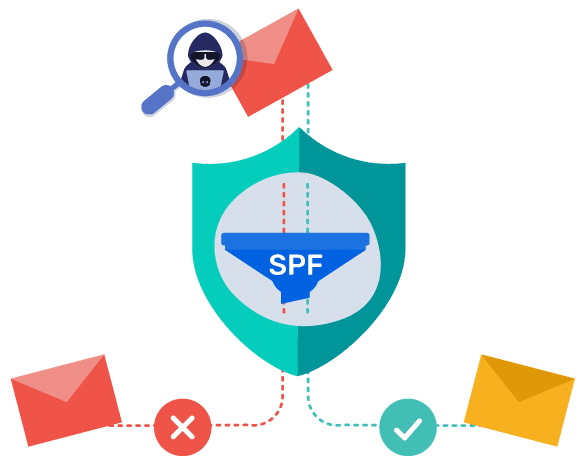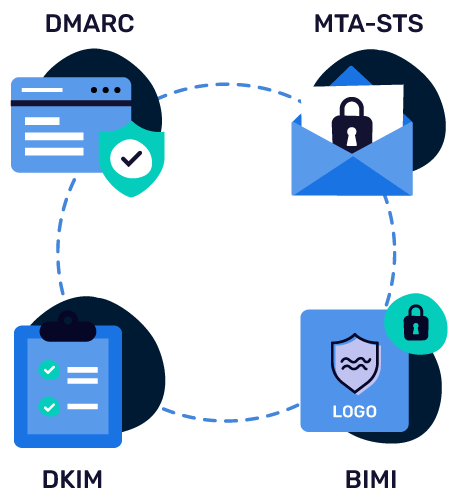Verify your SPF record validity
SPF Record Checker
Use this tool to lookup and validate your SPF record.
SPF Status
Record Checks
| Valid SPF record | |
| Failure Mode | |
| DNS Lookups below 10 | /10 |
| Void Lookups below 2 | /2 |
| Error Details | |
| Warning |
| Tag | Value | Description |
|---|---|---|
| v | v = spf1 Record version | |
| +ip4 | Allow the listed IPv4 addresses | |
| +ip6 | Allow the listed IPv6 addresses | |
| +include | Check the SPF record of the listed domain for a matching IP address | |
| +a | Allow the IP addresses listed in the domain’s A record | |
| +mx | Allow the IP addresses of the domain’s MX hosts | |
| +ptr | Allow the IP addresses of the domain’s PTR hosts | |
| +exist | SPF passes if an A record lookup of the listed domain returns a valid result | |
| +redirected | Replace the current SPF record with that of the listed domain | |
| -/~/? | Apply a hardfail/softail/neutral result if no other mechanisms match |
Get your SPF record validated in seconds with PowerDMARC’s SPF record checker today!
What is an SPF Record?
SPF (Sender Policy Framework) is an email authentication protocol that allows recipients to distinguish between the domain owner’s authorized list of senders, and unauthorized emails. Authenticating your email using SPF is the first step toward preventing domain name abuse and impersonation. To configure SPF you have to set up a DNS record. Pairing your SPF record with other email authentication DNS records can increase its efficacy against cyberattacks.
Our free SPF checker tool helps you look up and check for errors in your SPF record. SPF checks help you to verify your domain’s SPF (Sender Policy Framework) configuration.
What is an SPF Lookup Used For?
Our SPF lookup tool can instantly check your SPF DNS record. It can be used to:

SPF Record Examples
1. Basic SPF record: v=SPF1 mx -all
Explanation:
mx: Allows all the mail servers listed in the domain’s MX records to send email.
2. SPF record allowing specific IP addresses: v=SPF1 ip4:192.0.2.1 -all
Explanation:
ip4:192.0.2.1: Allows the server with the IP address 192.0.2.1 to send email.
ip4:198.51.100.1: Allows the server with the IP address 198.51.100.1 to send email.
3. SPF record including another domain’s SPF record: v=SPF1 include:_SPF.example.com -all
Explanation:
include:_SPF.example.com: Includes the SPF record of example.com. This means any servers authorized to send mail for example.com are also authorized for this domain.
How Our SPF Checker Works
Our SPF Checker Tool works by:
1. Retrieving the domain’s SPF record from DNS.
2. Parsing the record to understand its rules and mechanisms.
3. Evaluating the sender’s IP address against the SPF record.
4. Determining the authentication result (pass, fail, softfail, neutral, or permerror)…
Our SPF lookup tool performs the following functions:
1. Checks the existence of your published SPF record
2. Detects Multiple SPF Lookups
3. Evaluates SPF Record Validity
4. Validates IP Addresses and Domains
How Does SPF Impact Email Deliverability?
SPF can have a significant impact on email deliverability, hence it needs to be done right! This is why SPF checker tools play a crucial role in maintaining the proper functioning of Sender Policy Framework for implemented domains.
SPF Record Tags Explained
SPF records are published in the DNS (Domain Name System) and are comprised of several tags that define the syntax of the record. Here’s a breakdown of the commonly used SPF tags:
Why You Need to Test SPF Records
An SPF checker tool can reduce the chances of your legitimate email messages landing in the spam folder, improve your overall email security, and filter out fraudulent emails. Here are the various benefits of frequent SPF record checks:
Common SPF Configuration Mistakes
SPF (Sender Policy Framework) is a powerful email authentication method to prevent email fraud. However, domain owners often make mistakes during the configuration process that can undermine its effectiveness. Here are some common errors to avoid:
- Misalignment with Third-Party Vendors: Domain owners do not align their sending sources for third-party email vendors by following the sender alignment guidelines of their domain registrar
- Invalid or Broken SPF Records: Non-authorized sources get a free pass to send emails from your domain due to invalid or broken SPF records
- Lack of Complementary Protocols: Senders do not set up complementary email authentication protocols like DKIM (DomainKeys Identified Mail) and DMARC policies (Domain-based Message Authentication Reporting and Conformance) to improve their domain’s security further
- Ignoring Best Practices: Senders fail to follow optimal email deliverability practices recommended by email experts and instead rely only on traditional anti-spam filters and built-in email gateways
How To Troubleshoot SPF Authentication Failures?
To troubleshoot SPF Authentication Failures:
1. Use our SPF checker to find syntax and configuration errors
2. Resolve the errors by working with your DNS provider to edit or update your record
3. Monitor your DMARC reports to identify SPF-failing sources
4. Block or report malicious sources impersonating your domain name
5. Use an SPF optimization tool to always stay under SPF DNS lookup limitations
How to Make Sure Your SPF Record is Valid?
- Instead of relying on DIY methods that are prone to human errors, use an SPF record generator tool to create your record automatically.
- List down all your sending sources to add as authorized senders in your SPF record. Make sure you are updating this list from time to time to remove any redundant IP addresses or include that can add more lookups.
- Use a hosted SPF service that will make SPF record management easier. This will allow you to monitor and remove netblocks, keep track of your included domains, and comply with SPF limits.
- Make sure your SPF record does not exceed the 10 DNS lookup limit. This can be achieved with the help of an SPF flattening service or SPF macros – though we recommend the latter.
- Avoid using the SPF PTR mechanism. As PTR records resolve an IP address to a domain name, it slows down the DNS lookup process. It is also considered to be highly unreliable as per section 5.5 of RFC 7208.
- Make sure you are only publishing 1 SPF record per domain. Publishing multiple SPF records can invalidate your SPF configuration.
More Email Authentication Protocols to Explore
SPF Record Check FAQs
Check our comprehensive database of popular SPF record checker questions we come across often on our support forum.
- Log in to your Office 365 Admin Center
- Go to Settings > Domain
- Select your domain name and click on DNS records
- Check if your TXT status is ok, and review your SPF record from the list of DNS records.
- Increased likelihood of emails being marked as spam or rejected by recipient servers.
- Diminished email deliverability, affecting communication with clients, partners, or customers.
- Higher risk of phishing attacks succeeding, as spoofed emails may appear legitimate to recipients.
- Damage to the sender's reputation, potentially leading to being blacklisted by email service providers.
- Negative impact on brand reputation due to compromised email security and potential misuse of the sender's domain.
- Review the SPF record syntax and configuration for accuracy, ensuring that it includes all authorized email sources.
- Correct any misconfigurations, such as missing or incorrect IP addresses, or mechanisms.
- Update DNS records with the revised SPF information and allow time for DNS propagation.
- Test the revised SPF record using the SPF checker tool to verify its accuracy.
- Monitor email deliverability and SPF authentication status to ensure that the issues have been resolved effectively through DMARC reports.
- Consider consulting with our email security experts for assistance in troubleshooting and optimizing SPF configurations. Contact us now!
- Make sure you are following RFC-specified SPF restrictions. The details of these limitations have been explained more in the next question.
- Make sure you are authorizing all your email-sending sources, including third-party vendors. Failing to authorize email vendors and service providers you use to frequently send emails can lead to serious deliverability issues. Generally, you can find configuration guides in the support section on each of your vendor websites. Alternatively, you can check out our FAQs and blogs to find steps to configure SPF records for most vendors.
- Avoid using SPF mechanisms like the “PTR”. It is widely considered unreliable and slows down the authentication process. It also introduces more complexities in your SPF record.
- White SPF “-all” and “~all” can both be configured as a part of best SPF practices, in case of safe SMTP relaying we recommend using the softfail mechanism (~all). On a hardfail policy, relayed SMTP emails will fail SPF, leading to potential deliverability issues.
What Our Clients & Partners Say About Us

PowerDMARC is a highly reliable and effective domain security platform with a user-friendly interface.
Belgin Abraham (CEO, Channel Next)

“PowerDMARC has made enabling DKIM and DMARC settings, and monitoring results very easy for my domain.”
Mr. Toshikazu Watanabe (Domain Owner)






